|
|
|
Sort Order |
|
|
|
Items / Page
|
|
|
|
|
|
|
| Srl | Item |
| 1 |
ID:
107568
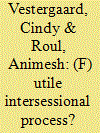

|
|
|
|
|
| Publication |
2011.
|
| Summary/Abstract |
During its thirty-five years, the Biological Weapons Convention (BWC) has been scarred by treaty violations, failed compliance negotiations, and ambiguous treaty language. Essentially a bruised paper tiger, the BWC adds no clarification to its distinction between biological activities for peaceful versus hostile purposes and has amplified-rather than lessened-mistrust in states' biological research and development potential. For the past two decades, these circumstances have generated multilateral annual discussions on BWC issues. From 2003 to 2010, intersessional talks centered on less controversial topics in an attempt to save the treaty from spiraling political tensions. States generally agree that this intersessional process was not futile and that it cooled some of the negative effects of the failed negotiations over a compliance protocol. At the upcoming Seventh BWC Review Conference this December, treaty members will weigh the utility of extending the process and its accompanying administrative Implementation Support Unit. The challenge will be to stimulate the evolution of the BWC beyond its hollow characterization to strengthen and inspire confidence in the treaty regime. This article examines the BWC's ambiguous language and how it has affected diplomacy, reflects on intersessional discussions, acknowledges the (limited) scope of appropriate peaceful activities that can be identified under the BWC, and addresses ways in which to reinvigorate the treaty.
|
|
|
|
|
|
|
|
|
|
|
|
|
|
|
|
| 2 |
ID:
152945
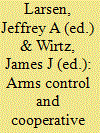

|
|
|
|
|
| Publication |
New Delhi, Viva Books, 2011.
|
| Description |
xiv, 288p.hbk
|
| Standard Number |
9788130915302
|
|
|
|
|
|
|
|
|
|
|
|
Copies: C:1/I:0,R:0,Q:0
Circulation
| Accession# | Call# | Current Location | Status | Policy | Location |
| 059059 | 355.02/LAR 059059 | Main | On Shelf | General | |
|
|
|
|
| 3 |
ID:
091670
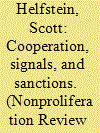

|
|
|
|
|
| Publication |
2009.
|
| Summary/Abstract |
This paper uses game theory and modeling to address the role of incentive structures and information dynamics in nuclear inspections. The traditional argument is that compliant states should be willing to allow inspections to prove their innocence, while proliferating states are likely to impede inspections. This argument does not take into account the historical variation in inspection, signaling, and sanctioning behaviors. Using a game theoretic analysis and model, it is shown that the separation of proliferators from nonproliferators only occurs when the likelihood of proliferation is high and punishment costs are moderate. The model assumes that states can choose how much to cooperate with inspectors and must pay opportunity or secrecy costs when inspections are effective. The results are tested against a set of real-life cases, providing support for the claims of historical variation and the model's deductive propositions
|
|
|
|
|
|
|
|
|
|
|
|
|
|
|
|
| 4 |
ID:
079623
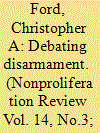

|
|
|
|
|
| Publication |
2007.
|
| Summary/Abstract |
The author offers a close analysis of Article VI of the Treaty on the Non-Proliferation of Nuclear Weapons (NPT), the treaty's only article dealing with disarmament, focusing upon both its text and negotiating history, and assesses its applicability as a standard for judging treaty compliance. The author critiques comments on Article VI made by the International Court of Justice in a 1996 case as legally ill founded and conceptually incoherent as a compliance yardstick. The only interpretation of Article VI consistent with its text and history, the author argues, is that it - as it says - merely requires all states to pursue negotiations in good faith; specific disarmament steps are not required. Claims that the 2000 NPT Review Conference imposed new legal obligations for disarmament or altered the meaning of Article VI are found to be mistaken; although the conference could theoretically have adopted interpretive criteria for understanding the meaning of Article VI, it did not in fact do so. Applying his Article VI compliance standard to the case of U.S. compliance, and comparing modern circumstances with those during the Cold War, the author also describes what he says is an excellent U.S. record of Article VI compliance
|
|
|
|
|
|
|
|
|
|
|
|
|
|
|
|
| 5 |
ID:
130342


|
|
|
|
|
| Publication |
2014.
|
| Summary/Abstract |
As the U.S. government winds up an interagency review of rules governing the export of large drones, the conflicting goals of nonproliferation and commerce are creating a new test of the 27-year-old Missile Technology Control Regime (MTCR). Observers do not expect big changes to the MTCR, which seeks to prevent the proliferation of unmanned systems capable of delivering weapons of mass destruction. The MTCR, a voluntary arrangement that now includes 34 countries, originally was intended to curb the spread of ballistic missiles and unmanned vehicles capable of carrying nuclear weapons. In 1993 it was amended to control systems carrying any weapons of mass destruction. It has become Washington's chief tool for controlling the spread of armed drones. "It's quite unlikely that we will see any radical change in the MTCR," Eric McClafferty, an attorney at Kelley Drye and Warren, a law firm in Washington that represents UAV manufacturers, said in a March 19 interview. "That said, there's a lot of pressure on the U.S. government to liberalize controls to make sure the U.S. doesn't get left behind in this market." The conflict has played out in a series of closed-door meetings over the last two months among the State, Defense, and Commerce departments as officials seek to update U.S. policy toward the burgeoning UAV market. Industry representatives have made their views known via technical committees that advise policymakers in these departments. "It's a pretty contentious fight" between the State Department's Bureau of International Security and Nonproliferation and the Pentagon's Defense Technology Security Administration, said Micah Zenko, a fellow at the Council on Foreign Relations, in a March 17 interview. The State Department says that "if you pull at the thread of MTCR, you will weaken the nonproliferation regime as a whole. The other side says the international market is going to supply these UAVs anyway," Zenko said. The heart of the issue is what kind of UAVs U.S. manufacturers can sell overseas. The MTCR imposes a "presumption of denial" for the export of so-called Category 1 UAV's, which are drones that can travel more than 300 kilometers with a payload of more than 500 kilograms. Drones that do not have those capabilities are classified as Category 2 UAVs and are not subject to such restrictive criteria. Two drones currently classified as Category 1-the Reaper, formerly known as the Predator, and the Global Hawk-have played a central role in U.S. aerial attacks on suspected Islamic militants in Pakistan, Somalia, and Yemen. Washington has approved the sale of an armed drone to only one country, the United Kingdom, although unarmed versions of these drones have been sold to Italy and South Korea.
The stakes of the MTCR review process are large politically and economically, observers say.
|
|
|
|
|
|
|
|
|
|
|
|
|
|
|
|
| 6 |
ID:
022043


|
|
|
|
|
| Publication |
May 2002.
|
| Description |
209-233
|
|
|
|
|
|
|
|
|
|
|
|
|
|
|
|
| 7 |
ID:
089069


|
|
|
|
|
| Publication |
2009.
|
| Summary/Abstract |
How do we assess the health of international regimes? Many analysts have insisted recently that the nuclear nonproliferation regime is in urgent need of repair or that it should even be discarded because of its supposed ineffectiveness. However, it is essential that statements about the regime being in crisis be scrutinized for veracity and utility. While the spread of nuclear weapons poses an undeniable and serious threat to international security, a mistaken crisis mentality with respect to the regime could lead to rash attempts to alter it in unnecessary or ineffective ways or, at worst, to discard it completely. This paper returns to a theoretical framework that differentiates regimes, across both issue areas and time, to provide a more specified evaluation of regime health. By disaggregating the nuclear nonproliferation regime and assessing the individual and interactive health of multiple dimensions, a number of dimension-specific, regime-strengthening policy recommendations emerge.
|
|
|
|
|
|
|
|
|
|
|
|
|
|
|
|
| 8 |
ID:
134084
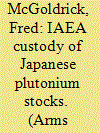

|
|
|
|
|
| Publication |
2014.
|
| Summary/Abstract |
Even before the 2011 Fukushima nuclear disaster shut down all 48 Japanese nuclear reactors, Japan's plan to reprocess its spent nuclear fuel and use the recovered plutonium and uranium as mixed-oxide (MOX) fuel in its nuclear power plants suffered from significant delays.
|
|
|
|
|
|
|
|
|
|
|
|
|
|
|
|
| 9 |
ID:
134085
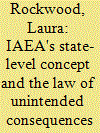

|
|
|
|
|
| Publication |
2014.
|
| Summary/Abstract |
In September 2013, the International Atomic Energy Agency (IAEA) Board of Governors reviewed a report by Director-General Yukiya Amano on efforts to further strengthen the effectiveness of safeguards and increase their efficiency.[1] The report described an approach to the implementation of safeguards that had come to be known as the "state-level concept."
|
|
|
|
|
|
|
|
|
|
|
|
|
|
|
|
| 10 |
ID:
105206
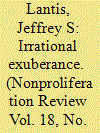

|
|
|
| 11 |
ID:
193522
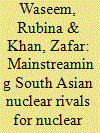

|
|
|
|
|
| Summary/Abstract |
There is a need for mainstreaming South Asian Non-NPT Nuclear Weapon States. India is an emerging market and Pakistan has the potential to become a future market for nuclear energy. Furthermore, they have nuclear weapons, making it important to take them on board in the Nuclear Nonproliferation Regime (NPR). Given the reality that they are not ready to roll back their nuclear program, there is a need to explore options for mainstreaming them especially in nuclear export control mechanisms. This article investigates the policy imperatives for the international community to address the South Asian Non-NPT-NWSs in the NSG.
|
|
|
|
|
|
|
|
|
|
|
|
|
|
|
|
| 12 |
ID:
151205
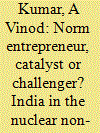

|
|
|
|
|
| Summary/Abstract |
The history of India’s interaction with the normative structures of the non-proliferation regime has been unique albeit tumultuous. The vibrancy of the roles and identities that India had attained in the normative churning of the regime is a useful case study to understand the dynamics of norm construction within the non-proliferation system. While the model of norm entrepreneurship can be used to explain this phenomenon, the Indian example shows that the spectrum of the term ‘agency’ can transcend the existing understanding of norm entrepreneurship. The article uses India’s non-proliferation history to examine how actors, based on their conceptions of interest and driven by various systemic factors, influence the norm construction process through different role identities.
|
|
|
|
|
|
|
|
|
|
|
|
|
|
|
|
| 13 |
ID:
138795


|
|
|
|
|
| Summary/Abstract |
The non-proliferation regime’s long-running discrimination against Pakistan peaked in 2008, when the 48 member states of the Nuclear Suppliers Group (NSG) granted an exceptional trade waiver to India. The group’s application of country-specific criteria for civil nuclear-technology cooperation has the potential to erode its credibility, and suggests the regime operates on the principle that, as George Orwell wrote, ‘all animals are equal, but some animals are more equal than others’.
|
|
|
|
|
|
|
|
|
|
|
|
|
|
|
|
| 14 |
ID:
158673
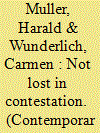

|
|
|
|
|
| Summary/Abstract |
With near universal membership, the nuclear nonproliferation regime can be considered a success of global nuclear governance. While it has proven robust since the Nonproliferation Treaty entered into force in 1970, the regime has faced continuous contestation, precisely because it is a delicate compromise between the nuclear and non-nuclear weapon states. In this article, we analyze the patterns of contestation within the regime as well as the actors driving these contestation processes. Our purpose is to assess how contestation has affected the development of nuclear norms. We show that contestation can lead to normative progress, result in blockage, or even lead to decay. We argue that the outcome depends on three factors: commitment by the powerful parties to appreciate the positions of the non-nuclear weapon states, the engagement of bridge-builders to shape compromises, and the construction of reciprocal gains for and compliance by all parties.
|
|
|
|
|
|
|
|
|
|
|
|
|
|
|
|
| 15 |
ID:
070156


|
|
|
| 16 |
ID:
184604
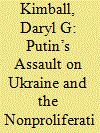

|
|
|
|
|
| Summary/Abstract |
President Vladimir Putin has chosen the path of destruction instead of diplomacy. His months-long buildup of a massive Russian invasion force encircling Ukraine and his decision on Feb. 21 to order Russian soldiers into the eastern Ukrainian provinces of Luhansk and Donetsk have set in motion a catastrophic war. Putin’s indefensible, premeditated assault on Ukraine will heighten tensions between NATO and Russia, increase the risk of conflict elsewhere in Europe, and undermine prospects for nuclear nonproliferation and disarmament—for years to come.
|
|
|
|
|
|
|
|
|
|
|
|
|
|
|
|
| 17 |
ID:
127626


|
|
|
|
|
| Publication |
2014.
|
| Summary/Abstract |
The biological and chemical weapon nonproliferation and disarmament regimes are often put forward as models of what the nuclear nonproliferation regime could (or should) be. But are these regimes effective? If so, is one stronger and/or more effective than the other? What is it that makes them relatively stronger than the nuclear nonproliferation regime? In this article, we return to and expand upon a framework for assessing regime health and effectiveness. We utilize this framework to engage in a comparative analysis of the chemical weapon (CW) and biological weapon (BW) nonproliferation regimes, respectively. Our analysis reveals that these two regimes are comparatively healthier than their nuclear counterpart. While some of their behavioral features might be troubling-such as the disputes over stockpile destruction of CW-these tend to be mitigated by the presence of a strong norm against possession and proliferation of both CW and BW. This norm is adequately embedded into the existing institutional features of the regimes in ways that do not exist in the nuclear nonproliferation regime.
|
|
|
|
|
|
|
|
|
|
|
|
|
|
|
|
| 18 |
ID:
077790


|
|
|
|
|
| Publication |
2007.
|
| Summary/Abstract |
The stage may be set for what could be a historic turning point in America's reliance on nuclear weapons to meet its fundamental national security interests. Proponents of a refurbished nuclear stockpile and infrastructure are convinced that nuclear weapons will remain central to U.S. security interests, yet they admit that there is no national consensus on the need for and role of nuclear weapons. Nuclear opponents are gravely concerned that to the extent nuclear refurbishment creates a global perception that nuclear weapons remain essential instruments, it will eviscerate nuclear nonproliferation measures precisely at a time when nuclear ambitions are growing. Moreover, opponents see deterrence through advanced conventional weapons as decisively more credible than any nuclear alternative. With hopes of elevating discourse to the national level, this article examines the key current arguments pro and con within the specialist community and forecasts changes in the U.S. nuclear arsenal over the next decade. It concludes with a brief prognosis on prospects for complete nuclear disarmament.
|
|
|
|
|
|
|
|
|
|
|
|
|
|
|
|
|
|
|
|
|